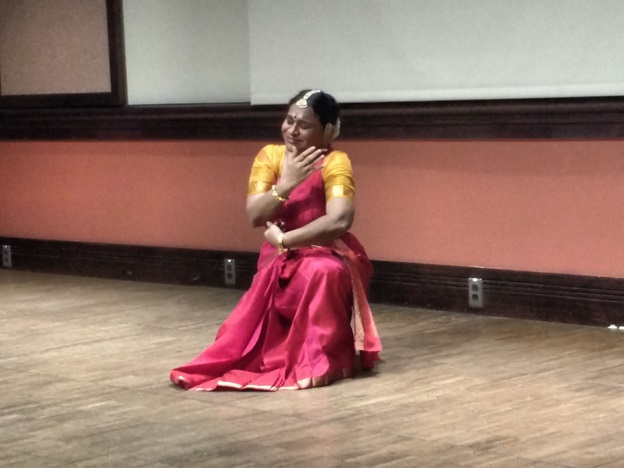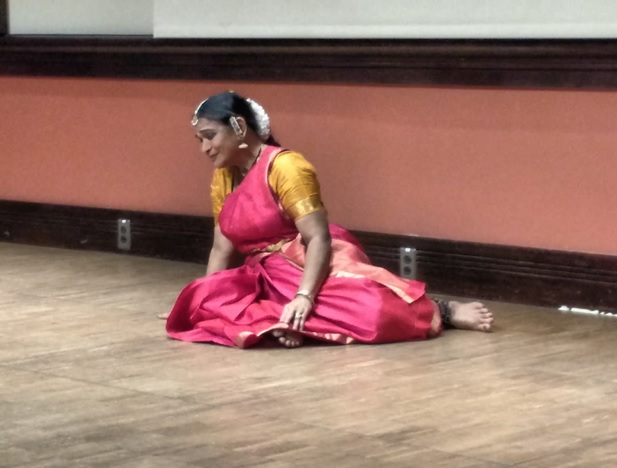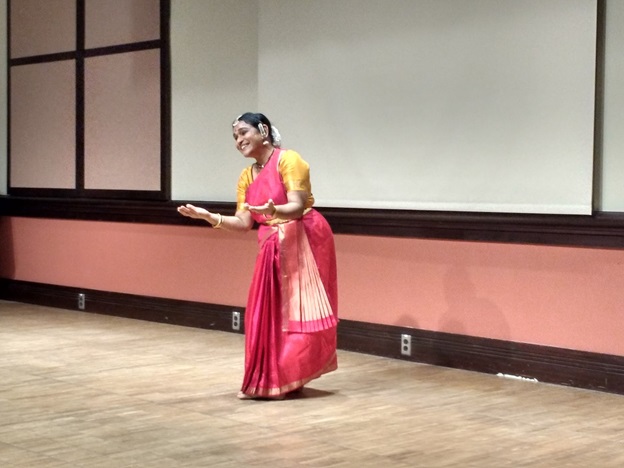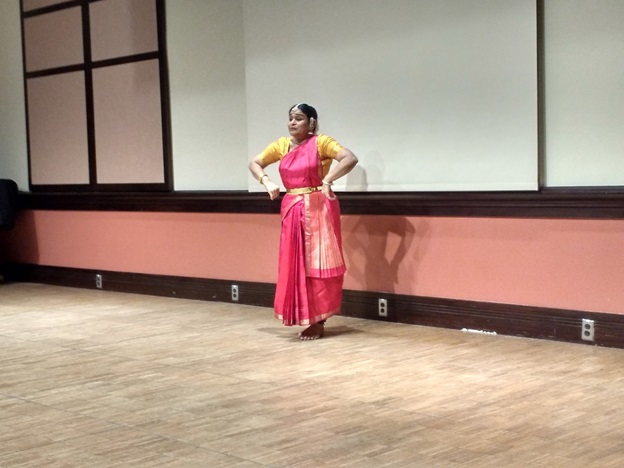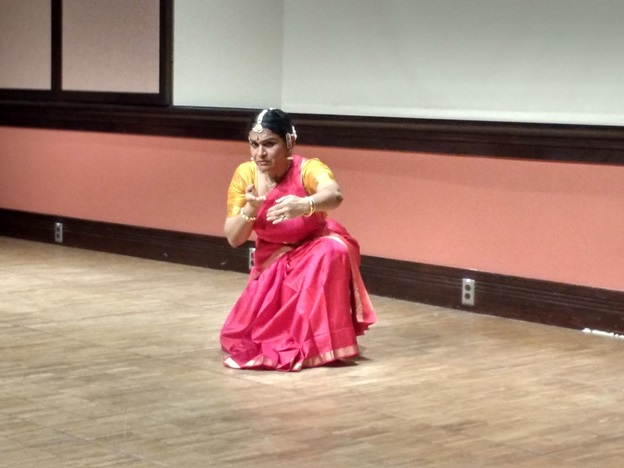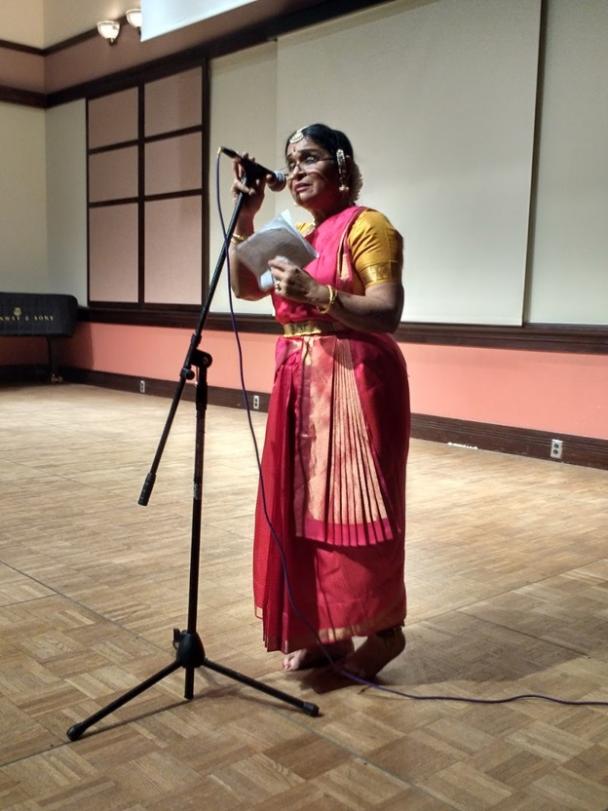Contribute
| Bragha Bessell And The Essence Of Abhinaya |
Pallavi Nagesha
08/25/2017
Bragha Bessell and the Essence of Abhinaya नहि रसादृते कशà¥à¤šà¤¿à¤¦à¤¾à¤°à¥à¤¥ पà¥à¤°à¤µà¤°à¥à¤¤à¤¤à¥‡ । (न.श ६.३३) nahi rasAdhrite kaschidArtha pravartate. (N.S 6.33) You cannot convey any meaningful ideas without evoking Rasa. (N.S 6.33) We have heard that the perfect storm of aesthetic delight arrives when the performer is able to evoke an impeccable maelstrom of emotions in the sahrdaya (the discernable audience). I am fortunate to have be in the eye of this storm for the past month. My journey with Bragha Bessell began in Liverpool in late July. I had seen her perform many years ago in the Boston area and was very excited for the chance to learn from her at Dance India. Serendipitously, she was also scheduled to perform and teach back home, and I jumped at the chance to continue to bask in this bliss. Bragha is, in my opinion, the uncontested queen of “abhinayaâ€. She is able to put all the emotions and experiences into a cauldron, use expression (abhinaya), and simply divine the meaning, the true vision to emerge. I am absolutely floored by how easily she can move through the various baavas to create rasa. MITHAS arranged for lecture demonstration at MIT, which, not surprisingly, was packed with rasikas who came to savor the very special flavor of abhinaya in padams and javalis. As Bragha explained, these beautiful poems have remained on the sidelines for many years for many diverse reasons. She is making a concentrated effort to revive them and add them to the mainstream Bharatanatyam repertoire. “There were days when a two or two and a half hour kutcheri with a focus on these items was common. People would sit patiently and listen to singers and watch dancers†bring these beautiful pieces to life, she said. The melody in these pieces is simply sublime. It is rich and fertile and in the hands of one as skilled as Bragha Bessell, they spring to life and transport the sahrdaya into rapture. As Bragha moves effortlessly from the distressed devotee to the naïve paramour, landing on so many other emotions in between, she creates the perfect storm of emotions that is sure to soak the audience in the sweetest rasa. She also has a very unique approach to choreography. As she explores the song, she forges a storyline that not only diverges from the padaartha, or the literal meaning of the song, but also brings nuanced and contrasting ideas. For example, in Vazhi Maraittirukkude, Bragha illustrates Gopalakrishna Bharati’s nuanced portrayal of Nandanaar’s emotions, going beyond the spirit and story. She seems to have tapped the very essence of both the poet and of the despondent Nandanaar. Accepting that he cannot enter the temple (due to the circumstance of his birth), all he now wants is to gaze upon his beloved Lord Shiva. “Can I never atone for my sins?†he asks, “if only my view were not blocked by this mountainesque bullâ€. Bragha not just brings this sad story to life, but she also breathes life (literally) into the gigantic bull and shows him moving so that Nandanaar can have his darshan. I am certain that there was not a single dry eye in the audience at the end of this item. Bragha’s interpretation and rendition was pure and, simply sublime. In the Khamas Javali, Appudu Manaasu, Bragha effortlessly portrays the playful ingenue. Both bashful and eager as she pours out her heart and her inability to control her reaction to the inviting glances of Lord Venkateshwara. The love of a young maiden is juxtaposed with the motherly love. In the Pilai Thamizh virruttam, the poet adores the Goddess Kantimati, forming an endearing bond of a mother and child. My 12 year old daughter was astounded at Bragha’s attention to detail. “I think she can move each muscle in her face individually, at will!†she exclaimed. This is absolutely true. I am completely certain that she can isolate the zxigomaticus minor and major, and move them independently and at will to suit the circumstance. In class, I often ask her to explain the use of all the elements of angikam in expression. “It should come automatically!†she says, but then, it takes many, many years of practice to master the movement of all the tiny muscles in our body! Bragha can create the hollow void of angst and despair in the hearts of the rasikas, as she did in the Kshetrayya padam, Payyada. With cries of “ayyayyo vegataaye†every heart (sa-hrdaya) drops along with her laments. She uses the melody in the song to enhance the pathos in her abhinaya so skillfully that the music, and dancer seem to melt away and we are presented with just this bowl of intense feelings. There is no beginning, no end, no actor, no director, no words, no actions, just a sea of emotions, in which you must drown. Whether as the virahotkanthita, or as a khandita nayika, Bragha is able to become that patra the vessel, and give us that taste of aesthetic delight. In the javali Sarasamulaade, rather than simply indicate the lover’s infidelity, she paints the picture of betrayal through her beloved’s liaisons with his lover. In Kshetrayya’s Moratopu, Bragha deftly moves through quarrel, jealousy, and disheartenment as she dwells upon lonely heroine waiting for her beloved muvva gopaala to forgive and forget. In yet another Javali, Kopametula, Bragha shows the enraged heroine, but with the poise and restraint called for by the lady’s status. “Yes, she is angry, but there is also love.†Bragha explains. “If you get so angry as to make him go away, then….†She also brings this sentiment as she plays the abhisaarika, confident and unabashed in her sensuality, yet dignified and elegant in the Subbarama Iyer’s padam, Yarukkagilum bhayama. She is able to conjure up the soul of the heroine she portrays and bring the entire episode to life, as if it is in the now and here. In Papanaasam Sivan’s Kaana Vendaamo, we feel the monotony in the daily grind of the common man. The strong desire is to see the lofty gopuram of Chidambaram and the life that binds are presented as opposing, but essential duties of life. Bragha leaves us with this palpable but elemental dissent that is so much a part of all our lives, with the choices we must make. Our favorite was the Kshetrayya padam, Nanne Pendlaadu. My 19 year old son and I have just returned having attended Dance India at the Milapfest in Liverpool, UK, where we learned this very padam from our beloved Bragha akka. It was as if she was still teaching us as she went through the emotions of mugdha, the innocent ingenue, madhya, the young maiden newly introduced to love, and prakalpa, the experienced lover. She skillfully glides through these emotions and takes us along with nothing but a glance! And in each moment, she also reaches out and continues to instruct us on the nuances of abhinaya. Her performance at the Killian Hall at MIT on August 9, 2017 was glorious and intangible and she is equally sublime in the classroom. Well known dance teacher, Sunanda Narayanan had arranged for a week-long workshop with Bragha akka that I had the pleasure of attending. As with her performances, her teaching style is very nuanced and unique. You often hear her saying things like “I am also learning from you!†or “We will see how it looks and fix it later.†She works with her students in the true essence of Natyashastra where the teacher is a conduit of knowledge, and the knowledge itself is explored as a prayoga shastra or a practitioner's discipline. “You need to make yourself look beautiful through your abhinaya.†She emphasises. It is not about the physical beauty, but that which glows when you are completely immersed in the role you play. You give yourself over, to become someone else completely and truly. Over the course of my learning with her, both in Boston and at Liverpool, we were able to discuss many subjects close to my heart. Although she professes to not know much, she is a trove of information. From technical, to spiritual, to esoteric, Bragha akka adds to your thirst for learning. Her perception, ideas, and approach to everything has impressed on me and all her students alike. For all her expertise and knowledge, she is still our “cute Bragha akkaâ€, humble and down-to-earth. She lives the tenant she preaches. What we know, she says, is but a drop in the ocean. If you seek to swim through it, you need to leave yourself on the shore, let go of your inhibitions, and work towards that learning. Work hard and practice constantly, that is her advice, her mantra. Bragha embodies the true artists who has offered herself completely to her art and has become the empty vessel, the patra that fills up with the truth of the moment, bringing great joy to the discerning connoisseur, the sahrdaya. Sunanda related an incident where a very senior dancer once said after Bragha akka’s concert, that all other dancers should just stop even trying. Watching Bragha Bessel dance is a rare and esoteric delight and to learn from her is transcendent. I am glad I got this opportunity to do both and I will continue to seek out many more such moments of bliss.
You may also access this article through our web-site http://www.lokvani.com/
